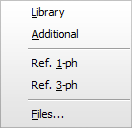|
Selecting the Library item will draw the predefined user specified object LIB. This object has no input data and cannot be connected with other objects because it has no input or output nodes.
|
Library
![]() Using this object will result in a $Include statement in the ATP-file inserted in the BRANCH part. No parameters are used in this case. The User specified section at the bottom contains an Edit button that brings up the Text Editor where the user can edit or import an external text. The user can type in the name of the component in the Name field. The text will be dumped to a file with this name and extension .lib and location in Result Directory (same as ATP file) when the ATP file is created.
Using this object will result in a $Include statement in the ATP-file inserted in the BRANCH part. No parameters are used in this case. The User specified section at the bottom contains an Edit button that brings up the Text Editor where the user can edit or import an external text. The user can type in the name of the component in the Name field. The text will be dumped to a file with this name and extension .lib and location in Result Directory (same as ATP file) when the ATP file is created.
Additional
![]() Like the Library component but in addition it allows the user to choose under which section in the ATP file to insert the text. The input dialog of this component contains a larger memo field where the user can write in free format text with a row and column indication below. The Additional section at the bottom contains an Edit button that brings up a more advanced Text Editor that allows the user to import a text from file of clipboard. This Text Editor also has a right-click context menu with an Insert option of 50 predefined request cards. There is no $Include field in this component because the text will be inserted directly into the ATP file. Instead the user can select the section; REQUEST, TACS, MODELS, BRANCH, SWITCH, STATISTICAL, SOURCE, INITIAL, OUTPUT, LOAD FLOW, MACHINE type 59/56, UNIVERSAL MACHINE, FREQUENCY COMP. The Order number can be used for fine tuning of the location within each section (together with ATP|Settings/Format-Sorting by Order). The three character text in the icon will adapt to the selected section.
Like the Library component but in addition it allows the user to choose under which section in the ATP file to insert the text. The input dialog of this component contains a larger memo field where the user can write in free format text with a row and column indication below. The Additional section at the bottom contains an Edit button that brings up a more advanced Text Editor that allows the user to import a text from file of clipboard. This Text Editor also has a right-click context menu with an Insert option of 50 predefined request cards. There is no $Include field in this component because the text will be inserted directly into the ATP file. Instead the user can select the section; REQUEST, TACS, MODELS, BRANCH, SWITCH, STATISTICAL, SOURCE, INITIAL, OUTPUT, LOAD FLOW, MACHINE type 59/56, UNIVERSAL MACHINE, FREQUENCY COMP. The Order number can be used for fine tuning of the location within each section (together with ATP|Settings/Format-Sorting by Order). The three character text in the icon will adapt to the selected section.
Ref. 1-ph
![]() Selecting Ref. 1-ph will draw the object LIBREF_1. This object has zero parameters and two nodes. Reference objects are not represented in the ATP input data file, but serve only as visualization of connectivity.
Selecting Ref. 1-ph will draw the object LIBREF_1. This object has zero parameters and two nodes. Reference objects are not represented in the ATP input data file, but serve only as visualization of connectivity.
Ref. 3-ph
![]() Selecting Ref. 3-ph will draw the object LIBREF_3. This object has zero parameters and two nodes. Reference objects are not represented in the ATP input data file but serve only as visualization of connectivity.
Selecting Ref. 3-ph will draw the object LIBREF_3. This object has zero parameters and two nodes. Reference objects are not represented in the ATP input data file but serve only as visualization of connectivity.
Files...
Besides the standard components, the user is allowed to create User Specified components. The usage of this feature requires knowledge about ATP's DATA BASE MODULARIZATION technique. The procedure that is described in the Advanced part of this Manual consists of two steps:
1. Creating a new support file (.sup) using the Library | New object|User Specified menu.
2. Creating a Data Base Module file (.LIB), which describes the object.
Selecting Files... in the component selection menu executes the Open Component dialog and the existing support files in the \USP directory are listed. If you select a .sup file from the list and click on the Open button, the icon of the object will appear in the middle of the active circuit window. In the dialog box of this component type there is a User Specified section with an Edit button which will bring up the Text Editor where a .lib file can be imported. A checkbox Send parameters is used if the library file is on the Data Base Module format with external parameters. A second checkbox Internal phase seq. is used if the phase extension 'A', 'B'… is hard coded inside the Data Base Module and only the five-character root node name should be sent. Henceforth the user specified objects operate similarly than standard objects.
